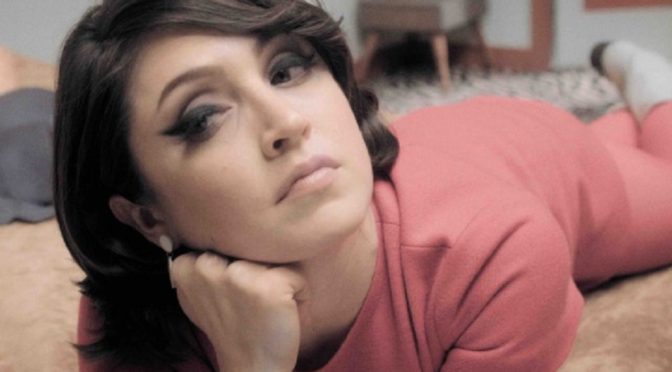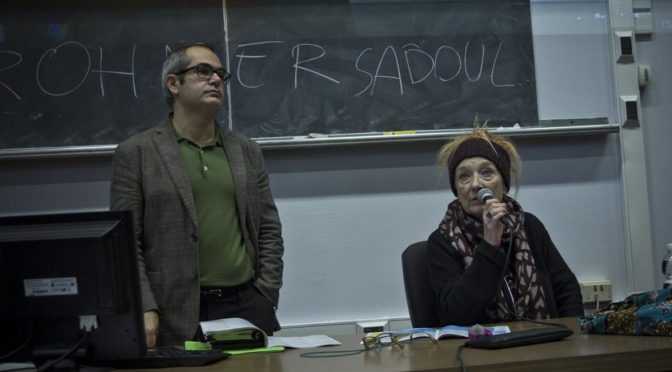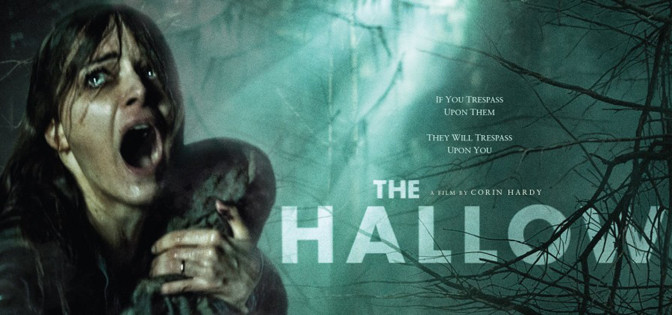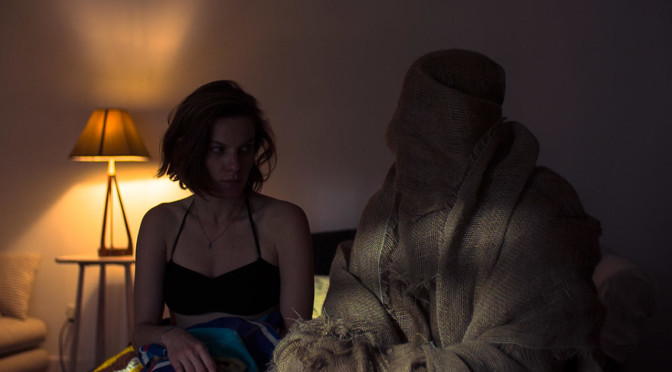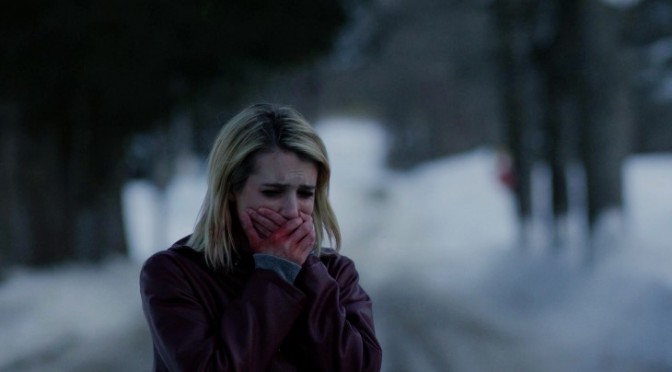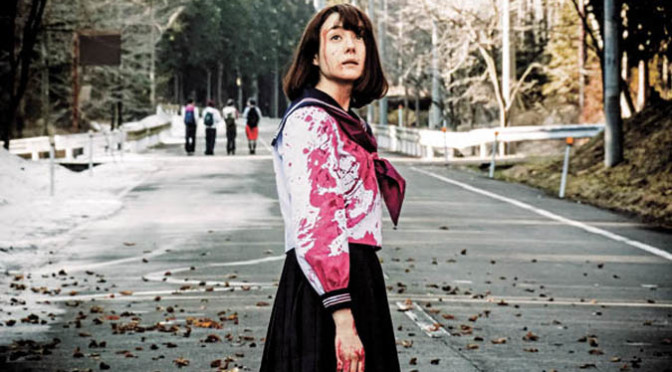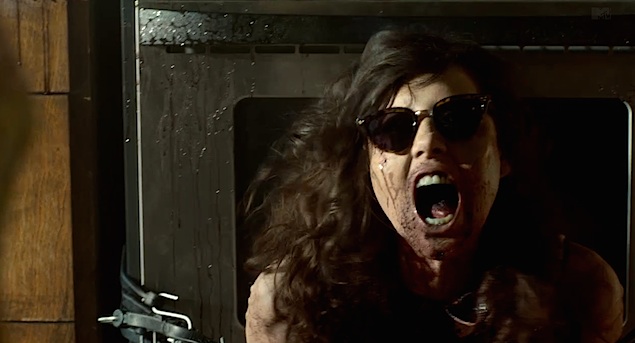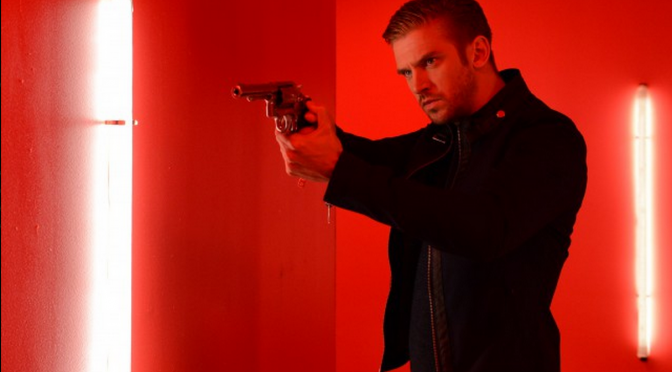The Arbalest si muove su due piani narrativi ben collegati: il primo in cui l’eccentrico Foster Kalt “racconta” la sua storia in un’intervista e un altro costituito di numerosi flashback che arrivano a comporre il carattere del protagonista.
Archivi tag: After Hours
Pyromanian by Erik Skjoldbjærg
Versione inglese a cura del Master in Traduzione per il Cinema, la Televisione e l’Editoria Multimediale
Article by: Valentia Di Noi
Translation by: Giulia Epiro, Chiara Mutti
Pyromanian is a movie by the Norwegian director Erik Skjoldbjærg, who was already well-known for Insomnia (1997), which Christopher Nolan signed to remake.
The film is set in 1981 in Finsland, Norway. Son of a fireman, Dag is a reserved young man, who, after the military service, goes back home to his family. From the very beginning, he clearly appears to be a weird character, as he is morbidly attracted by the fire. As a matter of fact, the viewer knows for the whole time that it is him who sets the neighbors’ houses on fire Continua la lettura di Pyromanian by Erik Skjoldbjærg
Yoga Hosers by Kevin Smith
Versione inglese a cura del Master in Traduzione per il Cinema, la Televisione e l’Editoria Multimediale
Article by: Silvia Villani
Translation by: Silvia Restelli, Chiara Tomasetta
Thanks to what they have learnt in yoga class, two young girls fight against a würstel-looking Nazi army with a bad copy of Jason from “Friday the 13th”. After having turned the terrible creature into cheddar paste, the only thing the girls worry about is not having their smartphones with them to immortalize the event. This is Yoga Hosers by Kevin Smith. It is the standard-bearer of the new Z-movies: a fair budget, a carefully chosen cast with some relevant names from the American movie industry and a specific attention to the filmed material both before and after the shooting.
Presentazione di TFF34 al DAMS
15 novembre. Palazzo Nuovo, Aula 33. Ore 09:00
Puntuale si ripresenta la stretta collaborazione tra il TFF e il Dams di Torino. Oggi l’ospite d’eccezione Emanuela Martini, direttrice della kermesse torinese, ha presentato il programma agli studenti, calcando la cattedra universitaria insieme al prof. Alonge durante la lezione di Storia del Cinema.
The Hallow by Corin Hardy
Article by: Luca Richiardi
Translation by: Kim Turconi
How do a young and loving couple react to the unknown?
The most primordial and essential life events can have serious effects on us, when they are experienced firsthand. The unknown is hidden behind the birth of a child, in the way in which such event changes the perception of the relationship between parents; the unknown can be found in tales and myths, among the folklore that is (or was) transmitted to children.
The Hallow, first feature film of the young British author Corin Hardy, deals with ambiguities and the unknown. The film initially titled “The Woods”, was premiered at the Sundance Festival, where it has been noticed for its qualities.
The Hallow is without any doubt a horror; it proudly represents the genre with all the trimmings and many clichés that are so appreciated by horror fans. We see a little family, happy to start their life together in their new isolated home surrounded by a lively, dark, dangerous forest. There is nothing wrong with using and abusing of such commonplaces, when it is done skillfully. This is what good films do, and they manage to do it in a stimulating and pleasant way.
Good films put the audience at ease by presenting a familiar atmosphere: a relaxed audience can be carried in different directions – even new directions – as long as the film itself is able to respect the audience. This is the case of The Hallow.
As he said himself during the press conference, Corin Hardy is a big fan of horror, especially of the golden age of Italian horror: the ’70s and ’80s variety of Dario Argento and Lucio Fulci – as evidenced by Corin’s shirt of Suspiria, worn with pride.
Hardy is well aware of what it needs to make a good horror film, and he shows great respect for his role models.
The Hallow is born from the legends of European folklore – Irish folklore in particular – and, for this reason, the film is set in Ireland itself. Hardy gathered together changelings, fairies, sylvan monsters, traditional creatures and he reshaped them with his own hands. He also showed to us some preliminary but beautiful sketches of the creatures design.
The Hallow is the result of measured quotations scattered throughout the film, good narrative choices that keep the tension high by playing on ambiguous situations, believable performances from the actors, great soundtrack and the light – almost invisible – hand of the director.
A horror film not to be taken lightly: it will scare, confuse and entertain you, and it will make you desire to watch another Corin Hardy’s film again.
“Lace Crater” di Harrison Atkins
A 22 anni Harrison Atkins dirige il suo primo lungometraggio, non nascondendo di aver tratto ispirazione dal film Begotten di Edmund Elias Merhige, dove i personaggi sono tutti incappucciati o in costume, non parlano mai né fanno capire alcunché di sé stessi, un po’ come il fantasma del film di Atkins.
Proprio per quanto riguarda il il fantasma, il regista rivela di aver scelto questo tipo di costume creato con sacchi di iuta, proprio per allontanare il personaggio dai soliti cliché riguardanti gli spettri. Inoltre dichiara di aver preso a modello le maschere del teatro kabuki, anche se difficilmente si trovano congruenze tra il film e il suddetto teatro giapponese.
Per quanto concerne la protagonista, la sua seconda vita su un gioco di realtà virtuale viene spiegata dalla relazione con l’alienazione postmoderna generata dai social media, dove nonostante la morte, l’account continua ad esistere.
I tratti stilistici dell’horror soprannaturale si mescolano con sfumature melodrammatiche che in alcuni casi spiazzano lo spettatore, come si nota nelle prime fasi dell’incontro fra Ruth ed il fantasma, dove la protagonista quasi psicoanalizza il suo interlocutore. Tutto ciò ammorbidisce la tensione del film nei momenti più intensi.
La colonna sonora è composta prevalentemente da musica elettronica combinata in alcuni casi a effetti rallenty in altri a fasi spaesanti con immagini che tendono allo psichedelico. Atkins rivela che queste immagini sono frutto del caso, in quanto in postproduzione copiando i file su hard disk, accidentalmente si scollegò il cavo, creando questo effetto che poi il regista ha voluto lasciare, per sottolineare lo stato di alienazione e le fasi di malattia che la protagonista Ruth vive in scena.
Per concludere, vi invito caldamente a tenere d’occhio questo regista che al suo esordio nonostante la giovane età, è riuscito a portare al Torino Film Festival un ottimo film e a stupire.
Kilo Two Bravo by Paul Katis
Article by: Luca Bellocchia Translation by: Rita Pasci
An excellent debut film from British director Paul Katis, after working his way up directing short films. The film is based on real events that happened to Mark Wright and a small unit of British soldiers stationed in Afghanistan, on a ridge near the Kajaki dam.
To disable a Taliban roadblock, a three-man patrol offers to carry out the mission. In a dried out river bed, one of them accidentally detonates a landmine, losing his leg in the process. This triggers a tense and claustrophobic narrative, where shots of vast deserted spaces define an indifferent and merciless setting. Although the film was shot outdoors, the action takes place in a very confined space.
What’s thought-provoking is the fact that even though the film is set in Afghanistan, the indigenous population is kept at a distance from the centre of the action, apart from the very beginning of the film.
Katis favours all that is anti-spectacular, the events are told in a dry and blunt manner. The outstanding performance of the actors playing the main characters cannot leave even the most insensitive viewer indifferent.
One thing that’s astonishing is the sense of humour of the soldiers, who, despite the tragic situation they find themselves in, still manage to defuse the tension. The soundtrack is reduced to the essential, the panting of the maimed and wounded and the noises made by flies cast the viewer directly into what’s happening, making everything more real.
Kilo Two Bravo is a film that gives an opportunity to elaborate on a point of view about war that is still unexplored, namely that of real war, where young people die simply because of distraction, misunderstanding, or just pure bad luck.
February by Osgood Perkins
Article by: Valentina Di Noi
Translation by: Chiara Toscan
Osgood Robert “Oz” Perkins, son of the actor Antony Perkins, proved to be a wonder with his first work as a director, the horror thriller February. We have already seen him acting in Psycho II and more recently screenwriting The Girl in the Photographs.
February is undoubtedly a film that creates an atmosphere. The theater was immersed in the sharp frost of the snowy streets that were so white they gave a sense of purity. However, such sensation was not meant to last, as soon those streets were going to be spoiled by trails of blood.
The film is set in Kempville, Ontario Canada. It’s February and the students of the all girls boarding school “Kempville” are getting ready to leave for their hometown for the winter break. Kate (Kiernan Shipka) and Rose (Lucy Boynton) are stuck at school because their parents have mysteriously failed to retrieve them. Rose finds herself forced to babysit Kate even if they are not friends but rather share resentment. At the same time, Joan (Emma Roberts), escaped from a mental health facility, is heading towards the school, while Kate starts to have a strange attitude.
In this feature film lingers not only tension but also teenage crisis and inner torments, especially through the characters of Rose and Kate. Its deconstructing montage might create confusion, however, at the end, all the pieces of the puzzle come together.
The film has no shades, only clear contrasts: the breaks between scenes as well as music change are clear.
Just one more thing: pay attention to the cutlery and Donnie Darko‘s bunny ears.
Riaru Onigokko / Tag by Sion Sono
Article by: Luca Richiardi Translation by: Cristiana Caffiero
Life is surreal.
There are movies with no soul which just try to step towards any directions without a reason. There are movies that are just empty and dreary. Well, this movie is just their opposite. “Tag” is directed by Sion Sono: it violently breaks in and manages to find a sharp conclusion both in a literal and figurative way. It confuses the feelings and perception of its audience but it doesn’t hide the fact that it has lost the sense of perception itself. This film needs to show its total dismay in order to penetrate the subconscious side of its audience and finally break through its conscious one. However, “Tag” is not addressed to an ordinary audience, for the simple reason that the movie is directed by Sion Sono. It’s a typical Japanese film with its peculiar artistic language which could by perceived as unfamiliar by a western audience, or at least by an audience not acquainted with Japanese pop culture.
This kind of audience might fail to notice the potential for social criticism hidden behind an excess of grotesque violence, which may appear then as empty divertissement: what has been defined, in jargon (particularly in the world of anime, manga and videogames enthusiasts) sa fanservice.
What exactly is fanservice? Excessive and pointless violence, schoolgirls in extra short miniskirts which are constantly lifted, eroticism, promiscuity, reification of the woman.
“Tag” contains all these elements. It’s thrown onto the screen in a shameless, exaggerated, intentionally provocative way, as if to ask: “Is this what you want?” As the film unravels, laughing at all this becomes a gesture that makes the spectator feel guilty.
This collage made of absurdities, which people may have fun in, is a heaven for “nerd” teenagers and hides a cruel and dreadful hell. It reveals itself step by step, while we follow the young female protagonist Mitsuko in her absurd suffering.
Among all this violence, torture and death, her loss of identity is what mostly harms. It makes her appear to be an empty box or a mannequin identical to many others. She looks as a figure, whose not uniform nature may be compared to that of Jesus and therefore doomed to sacrifice. It is a kind of essential sacrifice, a spontaneous gesture which gets away from this torture pattern felt as a function of a sadistic pleasure. And it takes place exactly in front of a parody which blames and despises these masses of obsessive fans.
What is such a heroic sacrifice aimed at? It is understood, its aim matches the film’s one: a sabotage internal to the system so that it can penetrate deeper and, hopefully, it can be able to reach and consequently wake up consciences, in order to take them away from this grotesque circle of hell.
ONCE UPON A TIME IN ZOMBIELAND… LIFE AFTER BETH BY JEFF BAENA
Article by: Nicola Gambarino
Translation by: Elettra Abatucci
Zachary Orfman (Dane DeeHan) is a rich middle-class boy, who lives in the wealthy district of Brian Grove. He lost his beloved girlfriend Bethany (Aubrey Plaza) due to a snakebite. The Slocums, Beth’s parents Maury (John C. Reilly) and Geenie (Molly Shannon), try to develop a filial relationship with Zac in order to keep Beth’s memory alive. They grieve, they chatter about the puddings that she liked to eat in her childhood and play chess until three in the morning.
However, Beth will soon literally get in touch with them, as nothing ever happened or as it was all just a trick. It seems like somebody in heaven decided that it was not her moment to push up the daisies. She is then ready to restart her life without having memory of what happened. With the help of her parents, Zach and Beth can live again their love story where they interrupted it; he seems to love his girlfriend if possible more than before. Then many strange things start happening in the neighborhoods, arousing Zach’s worries. At first, he was skeptic and joked around the fact of having a zombie girlfriend, but he will soon realize that it is the truth. It is only a matter of time before many departed ones decide to revive in order to hug again their beloved relatives… and possibly give them a bite.
Forget Joe Dante. Leave John Landis. Forget the first Ruben Fleischer as well. Jeff Baena, a brilliant first timer, sets George Romero’s revenants free in the streets of a smiling Suburbia, where Jewish Cabala clashes with Haitian voodoo, and the Yankees more Yankees than ever always keeps up with his stereotype: holding a Bible in one hand and a Desert Eagle in the other, feeding himself of B-movies and paranoia.
Dead people no longer rest in peace, as they have awakened in a bad mood, claiming rights that died out together with them. Love wins over death, but not over hunger, (there are many two-ways in the background playing on physical and sexual hunger). This politically incorrect comedy also denounces the absurdity of the US wealthy middle class, spiced up with a marvelous soundtrack provided by Black Rebel Motorcycle Club.
“I’m a zombie. How the fuck am I supposed to behave?” yells the amazing Aubrey Plaza to her boyfriend Dane DeHaan (another big revelation of the underrated fanta-mockumentary Chronicle by Josh Trank [2012]) while eating avidly his Saab’s seats. Exactly. How? Human nature, alive or not, is the central theme of this beautiful, yet wacky fairy tale, which mixes horror and drama. It is disturbing, but funny at the same time, it also cleverly speaks about human feelings, and relationships, making the audience reflect upon an issue: do we really wish our relatives departed for a better place, to return?
WHE ARE WHAT WE ARE: what we fear the most
Article by: Emanuel Trotto
Translation by: Giulia Magazzù
Who said that a remake is a less important film than the original? Certainly, if in the new product does not provide anything more – or even less – of what was suggested in the model, then the answer is “yes, it is just an unnecessary duplication”. Many recent operations of this kind prove that this theory is true (Carrie by Kimberly Pierce, for example). However, if starting from the original product we decide to take a completely different way, working on elements that become peculiar of the new feature, then we have something more: think of The Departed by Martin Scorsese and of the relationship with Andrew Lau’s Infernal Affairs. These two films are completely autonomous. Jim Mickle’s We are What We are belongs to this category.
We are What We are is a re-imaging of the Mexican film Somo the que hay by Jorge Michel Grau (2010). If the “prototype” (if we can define it so) is set in the streets of Mexico City, Mickle sets his work in the province of Castkills, the poorest area of the state of New York, anguished by floods. The floods bring out numerous buried human bones, not far from the home of the Parker family, which is mourning the death of the mother. The family is dominated by authoritarian father figure of Frank, who obliges the three children (two teenagers, Iris and Rose, and little Rory) to a period of forced fasting in view of an important ritual of which, since the mother has died, the eldest daughter Iris becomes the main celebrant. It consists of killing young women and then feeding themselves with their flesh.
Especially in this part, Mickle’s film differs widely from the original: eating human flesh is not something related only to a routine or to something ancestrally necessary, but it is much more: it consists in literally taking into account the evangelical concept of feeding oneself with the body of the Lord (as a matter of fact, the story unfolds between Friday and Sunday). It is also something atavistic, primitive, which survives in the tribal cultures, where the body of the defeated enemy is both a source of food and of the power of the winner. The victims are girls, and the story revolves mainly around the two older daughters: they are a little more than teenagers, with a irrepressible and longing sexuality that the father-master nips in the bud. Feeding on the sexually active (or immature) bodies of the victims gives them the power to get along without the carnal impulse. The temptation of the flesh with the flesh.
Genre films, and especially horror films, have always fielded the uncertainties and fears of the times in which they were filmed. Jim Mickle, who has always loved horror movies (his favourite movies are The Evil Dead by Raimi and Suspiria by Argento), uses them as a tool for a strong polemic against the institutions, a second level running parallel to the horror theme, as he had already done in Mulberry Street (2006) and Stake Land (2010).
Here, with a gothic film style setting, he focuses on religion, its madness, its most hidden side. Taking quite literally Stephen King, who argues that “in order to scare the others, we need to talk about something that scares us”, he sketched a dark film that speaks of faith that, in real life, can be terrifying. And the fear of the unknown that religion gives us is more frightening than anything else.
THE GUEST – THE 80’s ARE BACK WITH A BANG
Article by: Paolo Nosenzo
Translation by: Ilaria Codeluppi
The Petersons are a perfectly normal family, still grieving for the death of their elder son, Caleb, fallen in the Middle East. One day, a boy named David Collins knocks on their door, saying that he has served in the army with Caleb, and that he had promised him to take care of his beloved ones. At the beginning, they are a bit suspicious, but David soon gains the respect and affection of the whole family, including Caleb’s siblings, Anna and Luke. After a few violent episodes happen in the small community, Anna starts to suspect that David is hiding something, and that he’s not really who he says he is.
Continua la lettura di THE GUEST – THE 80’s ARE BACK WITH A BANG

